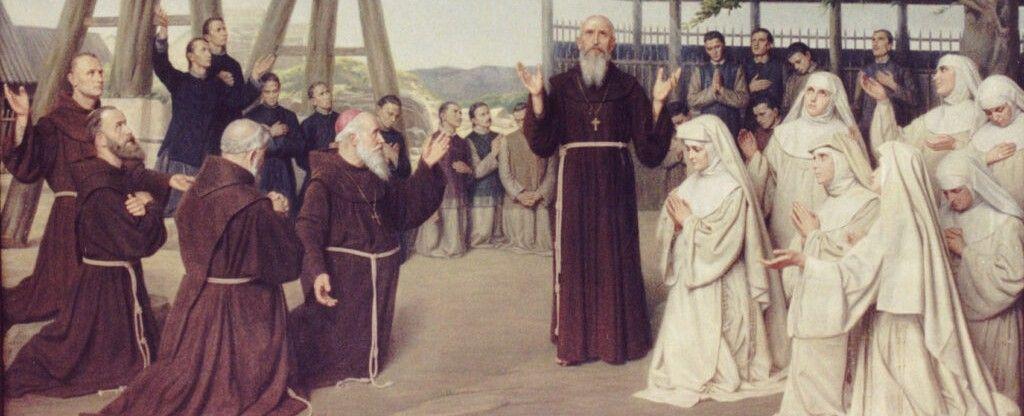26 Franciscan Martyrs in China: Caught in the Crossfire of Political Currents

On July 8, the Franciscan family celebrates the memory of Sts. Gregory Grassi, OFM, Marie-Hermine, FMM, and Companions, martyred in China in July 1900 during the Boxer Rebellion. They include fifteen European missionary religious (eight Friars Minor and seven Franciscan Missionaries of Mary) and eleven native Chinese Secular Franciscans.
Martyred during the 1900 Boxer Rebellion in China
As has often been the case, Western missionaries who had come to a foreign country to bring the Gospel to native peoples became caught in the crossfire of wider political currents. In 1898, several European governments exacted significant financial and territorial concessions from the Chinese Empire, capping a process that had been going on since the 1840s. The imperial government also promulgated some liberal "reforms" bringing significant Western perspectives into the Chinese educational system.

Bishop Francesco Fogolla, OFM (seated with white beard), coadjutor to Bishop Gregory Grassi, with a group of friar missionaries and Chinese seminarians. Bishop Fogolla and some of the others pictured here were victims of the massacre on July 9, 1900.
Goal to eliminate all foreign influence in China
In reaction, a strong militant populist movement, the "Righteous and Harmonious Fists" (Yihequan), known to Westerners as "Boxers,” began forming with the goal of eliminating all foreign influence in the country. The conservative Empress Dowager Cixi seized control of the government with the support of the "Boxers" and in June 1900 declared war on the Western powers and Japan.
Franciscans expand their presence
Italian Franciscan friar missionaries had begun working in Shanxi province in the 18th century, but with greater toleration of Christianity since the 1840s, they had expanded their presence greatly. The friars had maintained a mission around the city of Taiyuan for over 30 years. The Bishop of Northern Shanxi, Gregory Grassi, OFM, was based in the city, where the friars conducted a seminary to train a native Chinese clergy. There was also an orphanage, staffed by seven young Franciscan Missionaries of Mary, who had arrived only the year before, headed by Sr. Marie-Hermine de Jésus.

The Taiyuan cathedral of the Immaculate Conception, built in 1870 and badly damaged during the Boxer rebellion, was afterward restored. The friars' decision to build this prominent structure was seen by some Chinese as an affront to local culture. It is still functioning today.
Pressure rises against Christians
When war was declared in June 1900, pressure rose against Christians all over China. Unbeknownst to the Franciscans in Taiyuan, three Italian friars ministering in Southern Hunan, including the Vicar Apostolic, Antonine Fantosati, were being murdered by mobs at this same time. On July 1, the governor of Shanxi, Yuxian, issued a harsh edict calling on Chinese Christians to apostatize. On the afternoon of July 5, Boxer mobs raided the Taiyuan mission and apprehended five friars, the seven sisters, as well as eleven Chinese Secular Franciscans, of whom five were seminarians, the rest lay employees at the mission, as well as four other lay collaborators.

This montage, assembled in 1901 from earlier photos, shows some of the Franciscan martyrs of Shanxi.
Christians meet their deaths
Four days later, on July 9, all of the prisoners were stripped to the waist, tied together and led to the governor’s dwelling. On the way they were derided and beaten by the guards and the mob that lined the streets. After a brief show trial, Yuxian ordered them to be killed on the spot, and an indescribable scene followed. Soldiers closed in on the prisoners, hacking at random with their swords. The heads were severed for display and the mutilated remains thrown over the city wall to be eaten by dogs.
Christianity cannot be crushed
A number of Protestant missionaries and their families, including children, were also massacred at the same time: they had been lured to come into the city for "protection." Over the course of the summer, well over 2,000 Chinese Christians met violent deaths in the province of Shanxi. But Christianity could not be crushed—and just 25 years later, several hundred Franciscan missionaries were working actively in China with great effect. And in 1950—just after the advent of Communism—Taiyuan diocese numbered 41,000 Catholics in 24 churches.
Church canonizes large group of Chinese martyrs
This group of Franciscans was beatified in 1946 and canonized as saints in 2000 as part of a large group of Chinese martyrs. These are the martyrs we honor today:
Friars Minor martyred in Southern Hunan
- St. Cesidio Giacomantonio (Italy), priest, who was burned alive at mission in Hengyang on July 4
- Sts. Anthony Fantosati (Italy), bishop, and Joseph Mary Gambero (Italy), priest, who were stoned to death on July 7 upon returning to Hengyang
Franciscans martyred on July 9 in the city of Taiyuan
- Friars Minor: Sts. Gregory Grassi (Italy), bishop; Franciscus Fogolla (Italy), coadjutor bishop; Elias Facchini (Italy), priest; Theodoricus Balat (France), priest; Andreas Bauer (Alsace), lay friar
- Franciscan Missionaries of Mary: Sts. Marie-Hermine de Jésus (Irma Grivot, France); Maria della Pace (Marianna Giuliani, Italy); Maria Chiara (Clelia Nanetti, Italy); Marie de Sainte Nathalie (Jeanne-Marie Kerguin, France); Marie de Saint Just (Anne Moreau, France); Marie Adolphine (Anna Dierkx, France); Maria Amandina (Pauline Jeuris, Belgium)
- Secular Franciscans: Sts. John Zhang Jingguang (seminarian); Patrick Dong Bo Di (seminarian); John Wang Rui (seminarian); John Zhang Huan (seminarian); Philip Zhang Zhi He (seminarian); Thomas Shen Jihe (household worker); Simon Chen Ximan (aide to Bishop Fogolla); Peter Wu Anbang (refectorian); Francis Zhang Rong, (porter, janitor); Matthias Feng De (watchman); Peter Zhang Ban Niu (handyman)
Other lay employees of the mission who remained despite the danger
- Jacob Van Gudong (farmer, cook); Jacob Zhao Quanxin (servant); Peter Wang Erman (cook)
Another layman, James Zhao Zhunsen, had visited the prisoners on July 8 and willingly joined them on July 9.
Additional information about Sts. Marie-Hermine and her companions is available here.

The seven Franciscan Missionaries of Mary, headed by Sr. Marie-Hermine de Jesus, who had just arrived in China in 1899. They ranged in age between 25 and 36.
Main image: St. Gregory Grassi, OFM, and companions, Basilica of St Anthony of Padua, Via Merulana, Rome
Dominic Monti, OFM
Professor of Franciscan Research in the Franciscan Institute of St. Bonaventure University
Dominic V. Monti, OFM, is a Franciscan Friar of Holy Name Province (USA) and currently professor of Franciscan Research in the Franciscan Institute of St. Bonaventure University. He devoted the greater part of his ministry to teaching the History of Christianity, in particular the history of the Franciscan movement. He has contributed two volumes to the Works of St. Bonaventure series and is author of Francis & His Brothers, a popular history of the Friars Minor.

